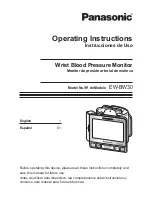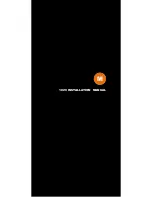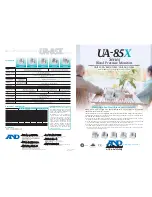
6
7
GB
7
GB
6
14. The monitor might not meet its performance specifications or cause safety hazard if stored or used
outside the specified temperature and humidity ranges in specifications.
15. Please do not share the cuff with other infective person to avoid cross-infection.
16. This equipment has been tested and found to comply with the limits for a Class B digital device, pursuant
to part 15 of the FCC Rules. These limits are designed to provide reasonable protection against harmful
interference in a residential installation. This equipment generates, uses and can radiate radio frequency
energy and, if not installed and used in accordance with the instructions, may cause harmful interference
to radio communications. However, there is no guarantee that interference will not occur in a particular
installation. If this equipment does cause harmful interference to radio or television reception, which
can be determined by turning the equipment off and on, the user is encouraged to try to correct the
interference by one or more of the following measures:
— Reorient or relocate the receiving antenna.
— Increase the separation between the equipment and receiver.
— Connect the equipment into an outlet on a circuit different from that to which the receiver is connected.
— Consult the dealer or an experienced radio/TV technician for help
17. This device complies with part 15 of the FCC Rules. Operation is subject to the following two conditions:
(1) This device may not cause harmful interference, and (2) this device must accept any interference
received, including interference that may cause undesired operation.
18. This blood pressure monitor is verified by auscultatory method. It is recommended that you check annex B
of ANSI/AAMI SP-10:2002+A1:2003+A2:2006 for details of verification method if you need.
SETUP AND OPERATING PROCEDURES
Fully Automatic Electronic Blood Pressure Monitor is for use by medical professionals or at home and is a
non-invasive blood pressure measurement system intended to measure the diastolic and systolic blood
pressures and pulse rate of an adult individual by using a non-invasive technique in which an inflatable cuff
is wrapped around the wrist.
1. BATTERY LOADING
a. Open battery cover at the back of the monitor.
b. Load two “AAA” size batteries. Please pay attention to polarity.
c. Close the battery cover.
When LCD shows battery symbol
, replace all batteries with new ones.
Rechargeable batteries are not suitable for this monitor.
Remove the batteries if the monitor will not be used for a month or more to avoid relevant damage of
battery leakage.
Avoid the battery fluid to get in your eyes. If it should get in your eyes, immediately rinse with plenty of
clean water and contact a physician.
The monitor, the batteries and the cuff, must be disposed of according to local regulations at the end of
their usage.
2. CLOCK AND DATE ADJUSTMENT
a. Once you install the battery or turn off the monitor, it will enter Clock Mode, and LCD will display time and
date by turns. See picture 2 & 2-1.
Picture 2
Picture 2-1
Picture 2-2
b. While the monitor is in Clock Mode, pressing both the “START” and “MEM” button simultaneously, a beep
is heard and the month will blink at first. See picture 2-2. Press the button “START” repeatedly, the day,
hour and minute will blink in turn. While the number is blinking, press the button “MEM” to increase the
number. Keep on pressing the button “MEM”, the number will increase fast.
c. You can turn off the monitor by pressing “START” button when the minute is blinking, then the time and
date is confirmed.
d. The monitor will turn off automatically after 1 minute of no operation, with the time and date unchanged.
e. Once you change the batteries, you should readjust the time and date.
3. CONNECTING THE CUFF TO THE MONITOR
The cuff is attached to the monitor when it is packaged. Should the cuff become unattached, align the two
plugs and four brackets of the cuff with the plug sockets and bracket sockets of the monitor and press the cuff
to the monitor until the plugs and brackets are securely attached.
4. APPLYING THE CUFF
a. Place the cuff around a bare wrist 1-2cm above the wrist joint on the
palm side of the wrist.
b. While seated, place the arm with the cuffed wrist in front of your body
on a desk or table with the palm up. If the cuff is correctly placed, you
can read the LCD display.
c. The cuff must be neither too tight nor too loose.
Downloaded from www.vandenborre.be








































